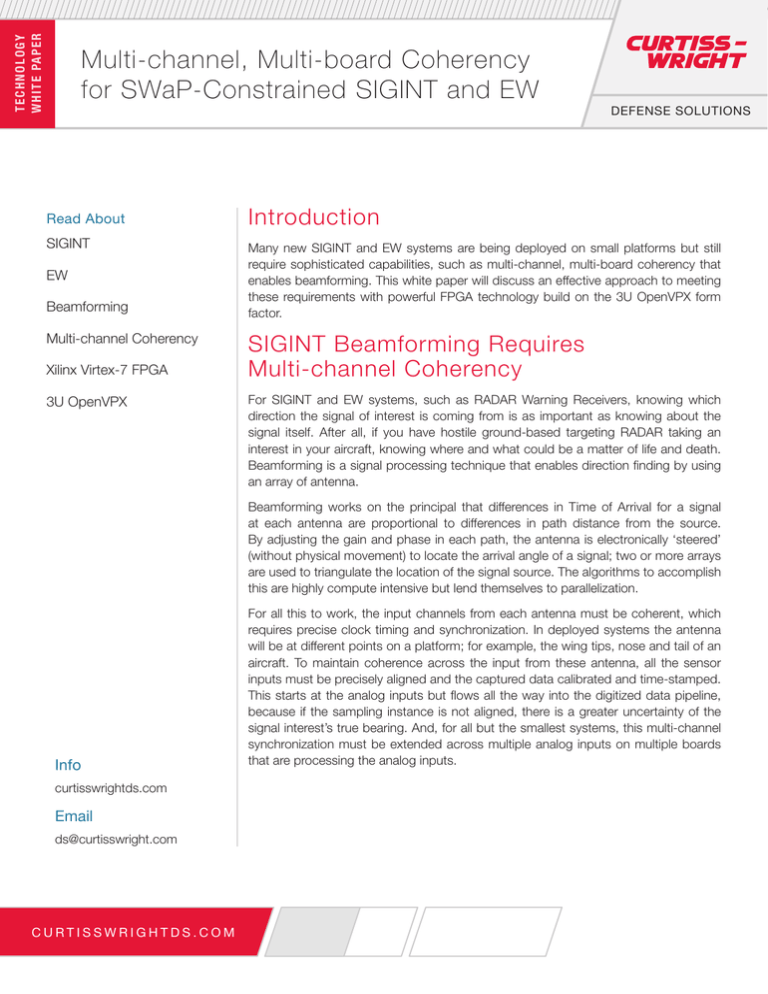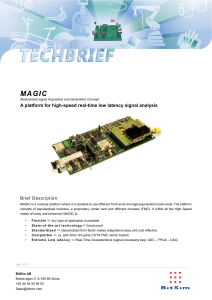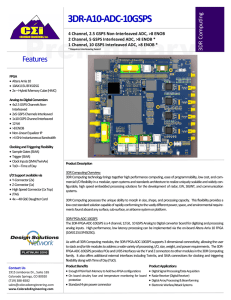
TECHN OLOGY
W HI TE PAP ER
Multi-channel, Multi-board Coherency
for SWaP-Constrained SIGINT and EW
Read About
SIGINT
EW
Beamforming
Multi-channel Coherency
Xilinx Virtex-7 FPGA
3U OpenVPX
DEFENSE SOLUTIONS
Introduction
Many new SIGINT and EW systems are being deployed on small platforms but still
require sophisticated capabilities, such as multi-channel, multi-board coherency that
enables beamforming. This white paper will discuss an effective approach to meeting
these requirements with powerful FPGA technology build on the 3U OpenVPX form
factor.
SIGINT Beamforming Requires
Multi-channel Coherency
For SIGINT and EW systems, such as RADAR Warning Receivers, knowing which
direction the signal of interest is coming from is as important as knowing about the
signal itself. After all, if you have hostile ground-based targeting RADAR taking an
interest in your aircraft, knowing where and what could be a matter of life and death.
Beamforming is a signal processing technique that enables direction finding by using
an array of antenna.
Beamforming works on the principal that differences in Time of Arrival for a signal
at each antenna are proportional to differences in path distance from the source.
By adjusting the gain and phase in each path, the antenna is electronically ‘steered’
(without physical movement) to locate the arrival angle of a signal; two or more arrays
are used to triangulate the location of the signal source. The algorithms to accomplish
this are highly compute intensive but lend themselves to parallelization.
Info
curtisswrightds.com
Email
ds@curtisswright.com
CURTISSWRIGHTDS.COM
For all this to work, the input channels from each antenna must be coherent, which
requires precise clock timing and synchronization. In deployed systems the antenna
will be at different points on a platform; for example, the wing tips, nose and tail of an
aircraft. To maintain coherence across the input from these antenna, all the sensor
inputs must be precisely aligned and the captured data calibrated and time-stamped.
This starts at the analog inputs but flows all the way into the digitized data pipeline,
because if the sampling instance is not aligned, there is a greater uncertainty of the
signal interest’s true bearing. And, for all but the smallest systems, this multi-channel
synchronization must be extended across multiple analog inputs on multiple boards
that are processing the analog inputs.
Radar Warning Receiver
Example
Radar Warning Receivers (RWR) use a number of RF inputs,
typically between four and six channels. These are at fixed
points around the aircraft; the associated data paths are
calibrated and RF fed into each of the ADCs. The relative
delay of the wave front across the antennas (and ADCs) can
be directly correlated to the direction of that emitter, such
as a targeting RADAR. This means that the accuracy of
the synchronization between all the ADCs, even if they are
spread across multiple cards, defines the baseline accuracy
of being able to distinguish direction. Just one sample cycle
error results in a very large error in the certainty of direction.
The example system below shows three VPX3-530 quad
receivers, controlled by a single SBC, all three cards
hooked up to a stopped common clock. The combination
of the master clocking, and the ability to stop for multi-card
sync, enable precise synchronization to be established.
The backplane data paths allow the data to be streamed
to a common FPGA and therefore to be processed to
create the Pulse Descriptor Words (PDWs). The amount of
processing required and the real-estate required to fit the
require converters means that (today) it’s difficult to fit it on
a single small factor card, making multi-board sync a key
consideration.
SBC + Master
Clock Generator
FPGA Sub-system
Configuration
Controller
FLASH SDRAM
Temperature
Sensors
1PPS
5V/3V3
JTAG
Header
Power
Sensors
Elapsed Time
Indicator
JTAG
x8 GTH/HSS
x8 HSS/PCIe 2/3
2x RS485
2x RS485
x28 LVDS (1.8V) I/O
JTAG
4xPCIe2
IO Sub-system
ADC/DAC clocks
4GSPS 12b
(2x 2.0 GSPS)
4GSPS 12b
(2x 2.0 GSPS)
x64
1PPS
5V/3V3
2/4GB DDR3
SDRAM
Temperature
Sensors
JTAG
Header
x8 GTH/HSS
x8 HSS/PCIe 2/3
2x RS485
2x RS485
x28 LVDS (1.8V) I/O
JTAG
Power
Sensors
x64
Elapsed Time
Indicator
Virtex-7
VX690T
FPGA
x64
2/4GB DDR3
SDRAM
FPGA Sub-system
Configuration
Controller
FLASH SDRAM
Virtex-7
VX690T
FPGA
2/4GB DDR3
SDRAM
1PPS
5V/3V3
4xPCIe2
Clock
distribution/
control
Balun
Balun
5.6 GSPS
14b DAC
Balun
Balun
5.6 GSPS
14b DAC
Balun
Balun
LVPECL
LVPECL
IO Sub-system
ADC/DAC clocks
4GSPS 12b
(2x 2.0 GSPS)
4GSPS 12b
(2x 2.0 GSPS)
5.6 GSPS
14b DAC
5.6 GSPS
14b DAC
x64
2/4GB DDR3
SDRAM
Temperature
Sensors
x4 HSS link
Dual 4GSPS (Quad 2GSPS)
Clock
distribution/
control
Balun
Balun
Balun
Balun
Balun
Balun
LVPECL
FLASH SDRAM
JTAG
Header
Power
Sensors
x8 GTH/HSS
x8 HSS/PCIe 2/3
2x RS485
2x RS485
x28 LVDS (1.8V) I/O
x4 PCIe link
FPGA Sub-system
Configuration
Controller
Elapsed Time
Indicator
Virtex-7
VX690T
FPGA
x64
24xPCIe2
Switch
w/ DMA
2/4GB DDR3
SDRAM
I/O
x64
8 xPCIe 2
IO Sub-system
ADC/DAC clocks
4GSPS 12b
(2x 2.0 GSPS)
4GSPS 12b
(2x 2.0 GSPS)
Intel® Core™ i7
Quad Core
2.1 GHz
2/4GB DDR3
SDRAM
1333MHz
Quad Receiver
Dual 4GSPS (Quad 2GSPS)
LVPECL
Clock
distribution/
control
Balun
Balun
5.6 GSPS
14b DAC
Balun
Balun
5.6 GSPS
14b DAC
Balun
Balun
LVPECL
LVPECL
DDR3
SDRAM
2-8 GB
The other dimension of challenge is driven by a growing
need for SIGINT and EW in positions closer to the warfighter.
Capabilities that were initially deployed on a few large
platforms, and used by theater-level operations, are now
required in some form or other across the battlefield. This
means that sophisticated systems are now being deployed
on a range of smaller platforms, with all the resulting SWaP
constraints.
Quad Receiver
Dual 4GSPS (Quad 2GSPS)
Clocks & sync
8 xPCIe 2
1333MHz
Today’s SIGINT and EW systems face additional, growing
challenges in two dimensions. First, they must operate at
higher and higher frequencies, as adversaries seek to avoid
detection by moving their communications into the L-band.
Coherence at higher frequencies demands extremely precise
clocking and very low latency processing of the signals. The
requirement for lower latencies is putting a premium on high
performance parallelization of beamforming algorithms.
And, in addition to parallelization, there must be low latency
methods for merging the multi-channel data flows so that
they are aligned on the correct data sample.
Quad Receiver
XMC
XCLK1
DDR3
SDRAM
2-8 GB
New SIGINT and EW
Systems Have Additional
Demands
x4 HSS link
Figure 1: Example of a Radar Early Warning Configuration
CURTISSWRIGHTDS.COM
2
Technology Trends –
Powerful FPGAs & 3U
OpenVPX
To meet the SIGINT and EW performance challenges,
especially those for low latency processing, system
designers have adopted FPGAs. For high speed digitization,
the use of devices like FPGAs is usually the only practical
way to catch and process the data. After an ADC digitizes a
signal, it moves to an FPGA that acts on it; for beamforming
this includes digital down conversion and filtering, then gain
and phase adjustments.
Because they can implement extreme parallelism, with
hundreds of DSP blocks operating in parallel, FPGAs are
very well suited for processing intensive beamforming
operations. As new generations of FPGAs evolve, they
deliver more performance and greater I/O capability,
allowing new designs to keep pace with more stringent
requirements. For example, the Xilinx® Virtex®-7 FPGA
delivers roughly twice as much processing power as the
previous generation Virtex-6.
Figure 2: Xilinx Virtex-7 FPGA,
twice the performance of the Virtex-6
An FPGA implementation also permits optimization by IP
that insures coherency across multi-channel data flows.
This type of IP, specific to beamforming, executes low-level
FPGA operations with great efficiency.
Addressing the SWaP constraints of small platform SIGINT
and EW demands a small form factor solution. A wide
range of embedded defense applications are moving to 3U
OpenVPX™ as an effective, flexible industry standard. The
compact size and modularity of the 3U form factor makes
it a popular choice for the latest defense applications, while
the OpenVPX standard is designed to directly connect
cards with high-speed serial fabric on the backplane
The VPX3-530 3U OpenVPX
Virtex-7 FPGA ADC/DAC
The Curtiss-Wright VPX3-530 is a current example of a
board designed to meet SIGINT and EW requirements for
low latency beamforming operations with multi-channel,
multi-board coherency. The VPX3-530 is a rugged dual
channel 4 GSPS ADC/DAC packaged in the compact 3U
OpenVPX form factor. The card has a user-programmable
Xilinx Virtex-7 FPGA linked to two 4 GSPS 12-bit (or four
2 GSPS) analog inputs and two 5.6 GSPS update rate
(maximum 2.8 GSPS data rate) 14-bit analog outputs with
XC7V690T FPGA.
The VPX3-530 provides in one unit all the necessary I/O
resources for the ADC, DACs, high-speed DDR3 SDRAM,
high-speed PCI Express® (PCIe) and serial links – along
with FPGA-driven parallel I/O to the OpenVPX backplane.
At the core of the VPX3-530, the user-programmable
Xilinx Virtex-7 VX690T FPGA is supported by high-speed
DDR3L memory resources. These include flash memory or
DDR SDRAM configuration memory, which are capable of
storing FPGA configuration images. The host CPU, by way
of a PCIe interface, updates these images. Configurations
are downloadable from the host, through DDR SDRAM,
bypassing the non-volatile flash.
At higher frequencies, multi-channel, multi-board
synchronization can be challenging. There are layers of
synchronization that come into play starting with the clock
source. For multi-channel synchronization a master clock
reference is essential for coherent operation. It must also
be a good quality clock because jitter directly translates into
noise – and at higher frequencies, the jitter becomes more
significant. Supporting VPX3-530 is the XCLK1, a multichannel, high quality, low jitter, phase matched output clock
generator. The XCLK1 can use either an onboard clock
source or an even higher quality external reference to drive
the XCLK1 fanout buffers.
When
preparing
for
multi-channel,
multi-board
synchronization using the XCLK1, the VPX3-530s in a
configuration will undergo a synchronization phase via a
user application command. This primes each of the VPX3530 via a trigger in and out daisy chain to enter this mode.
During this cycle, the XCLK1 is momentarily held in reset (the
sample clock is stopped). This allows the ADC data paths
Taken together, these two tech trends point to the need for
solutions implementing the latest generation of FPGAs on a
3U OpenVPX module.
CURTISSWRIGHTDS.COM
3
to be aligned in various ways. For example, each ADC has a
demultiplexed digital interface and so the correct sample in
the pipeline needs to be matched up to the correct sample
clock (and dividers). Once complete, the XCLK1 clock
outputs are released in a controlled manner (no glitches)
ensuring that the ADC will be allowed to digitize data and
that all ADCs are released at the same time. Further IP
monitors the ADCs to ensure the devices remain in sync
and in particular over temperature.
The timing parameters needed to achieve cycle-accurate,
coherent sampling at these speeds, up to 4 GSPS,
accounts for the majority of the IP that comes supplied with
the VPX3-530.
RF CLK 0
RF CLK 1
Clock
Distribution/
Control
ADC/DAC clocks
Balun
ADC 1
Balun
ADC 2
Balun
ADC 3
Balun
DAC 0
Balun
5.6 GSPS
14b DAC
DAC 1
Balun
5.6 GSPS
14b DAC
TRIG In
LVPECL
LVPECL
Direction finding applications require beamforming with
coherency across channels from an array of antenna. At
high frequencies, this requires an ADC card with powerful
FPGA processing, precise clocking and IP supporting low
latency synchronization.
The Curtiss-Wright VPX3-530 meets these requirements
within a compact 3U OpenVPX form factor, enabling
highly effective SIGINT and EW implementations on small
platforms.
I/O Sub-system FPGA Sub-system
ADC 0
TRIG Out
Summary
4 GSPS 12b
(2x 2.0 GSPS)
4 GSPS 12b
(2x 2.0 GSPS)
Flash-
SDRAM
Configuration
Controller
Temperature
Sensors
5V/3V3
Power
Sensors
1PPS
Elapsed Time
Indicator
JTAG
JTAG
Header
x8 HSS/PCIe 2/3
x8 GTH/HSS
Virtex-7
VX690T
FPGA
x64
2/4 GB DDR3
SDRAM
x28 LVDS (1.8V) I/O
2x RS-485
2x RS-485
x64
2/4 GB DDR3
SDRAM
Figure 3: Figure : VPX3-530 Block Diagram
CURTISSWRIGHTDS.COM
4
Authors
Learn More
White Paper: Analog Input Performance of VPX3-530
VPX3-530 Dual 4 GSPS ADC
Jeremy Banks, BSc (Hons) in
Electronic and Electrical Engineering
Product Marketing Manager
Curtiss-Wright Defense Solutions
CURTISSWRIGHTDS.COM
© 2015 Curtiss-Wright. All rights reserved. Specifications are subject to change without notice. All trademarks are property of their respective owners.
W25.0315
5






